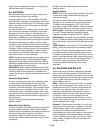
9 -33
7. Replace the vent caps. It is not necessary to
tighten more than finger tight.
8. Wash off the battery to remove electrolyte which
may have spilled.
Battery Electrolyte First Aid
External contact:
Flush with water.
Eyes:
Flush with water for at least 15 minutes and get
medical attention immediately!
I
nternal contact:
Drink large quantities of water.
Follow with Milk of Magnesia, beaten egg or vegetable
oil. Get medical attention immediately!
IMPORTANT:
In case of internal contact, DO NOT
induce vomiting!
Inspection, Cleaning, Drying, and Maintenance
Inspect the top of battery, terminals, cables, terminal
posts, and case for any accumulation of dirt, corrosion
cracks or loose or broken parts. Keep battery and its
terminals clean. Inspect monthly to maintain best
performance. Replace battery if damaged.
Remove hold down and bolt and lift battery out. Clean
or service battery away from unit. Remove corrosion
from battery terminals and cable connections with wire
brush, then wash with a weak baking soda solution.
Scrub the exterior of the battery and cable terminals
with a nonmetallic brush which has been dipped into a
mixture of baking soda and water.
After cleaning, apply a thin coat of grease or petroleum
jelly to terminals and cable ends to retard corrosion.
Reinstall battery.
Check the alternator voltage regulator output (if used)
at every periodic maintenance inspection. Over
charging is a common cause of battery failure.
Electrolyte Level
Every 25 hours of operation, check electrolyte level of
each cell by removing caps one at a time. The
electrolyte level should be at level indicated. Use
distilled water to fill each cell if needed. Install and
tighten each cap after checking.
IMPORTANT:
When distilled water is added to battery
during freezing weather, battery must be charged to
mix water with electrolyte, or water will remain at top
and freeze.
Charging
ALWAYS follow information provided on battery by
battery manufacturer. Contact battery manufacturer for
extensive instructions to charge battery.
Place unit on a level surface, shut off engine and open
battery compartment to gain access to battery.
Disconnect negative (-) cable first, then positive (+)
cable.
To charge battery:
1. Loosen strap and remove battery from unit.
2. Place battery on bench or other well ventilated
place where electrolyte spill will not create
damage.
3. Remove caps and fill each cell to level indicated
with electrolyte at 1.265 specific gravity at 80
o
F
(27
o
C).
4. Let battery stand for one half hour.
5. Check electrolyte level and add more if necessary.
6. Connect positive (+) lead of charger to positive (+)
terminal, and negative (-) lead to negative (-)
terminal.
7. Charge the battery at two and a half amps for ten
hours or until all cells are gassing freely and the
specific gravity is constant over three 30 minute
intervals.
Models with Briggs & Stratton Engines
Models with Robin Engines
1
1
2
2
3
3
4
4
Figure 30
1. Fuel Cap
2. Negative Battery Cable
3. Battery
4. Positive Battery Cable
and Kohler Engines


















